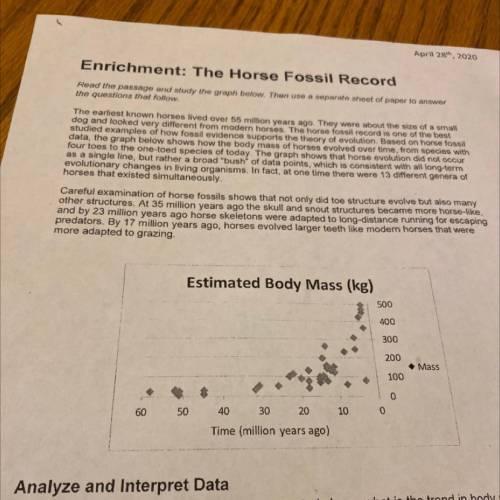
Biology, 21.01.2021 01:00 samarkanduzbek
Is the body mass evolution in horses an example of microevolution changes or macroevolution? Explain your answer by citing examples of both micro and macro evolution.


Answers: 1


Another question on Biology

Biology, 22.06.2019 00:10
The kind of fertilization found in the majority of aquatic animals is (internal or external) fertilization.
Answers: 1

Biology, 22.06.2019 00:30
When analyzing tree rings, what do scientists assume a thin ring indicates?
Answers: 2

Biology, 22.06.2019 03:00
In 1959, doctors began using the powerful antibiotic methicillin to treat infections of staphylococcus aureus, but within two years, methicillin-resistant strains of s. aureus (mrsa) appeared. how did the resistant strains of s. aureus emerge? in 1959, doctors began using the powerful antibiotic methicillin to treat infections of staphylococcus aureus, but within two years, methicillin-resistant strains of s. aureus (mrsa) appeared. how did the resistant strains of s. aureus emerge? staphylococcus aureus bacteria that were able to synthesize cell walls using a protein that was not affected by methicillin survived the methicillin treatments and reproduced at higher rates than did other individuals. over time, these resistant individuals became increasingly common. in response to treatment of staphylococcus aureus infections with methicillin, some bacteria began to synthesize cell walls using a protein that was not affected by methicillin. these bacteria survived the methicillin treatments and reproduced at higher rates than did other individuals. over time, these resistant individuals became increasingly common. in response to treatment of staphylococcus aureus infections with methicillin, bacterial populations gradually began to synthesize cell walls using a protein that was not affected by methicillin.
Answers: 3

Biology, 22.06.2019 03:30
In a hypothetical breed of dogs, coat color is controlled by two genes. there are six different coat colors in this breed: black, brown, cream, gray, silver, and tan. consider the following crosses. cross 1: black females from a lineage of all black dogs are crossed with brown males from a lineage of all brown dogs. f1 males and females are all black. when f1 are intercrossed, f2 males and females are black or brown. cross 2: black females from a lineage of all black dogs are crossed with tan males from a lineage where all males are tan and all females are cream. f1 males are black, f1 females are gray. when f1 are intercrossed, f2 males and females are black, brown, gray, or tan. cross 3: silver females from a lineage where all females are silver and all males are gray are crossed with brown males from a lineage of all brown dogs. f1 males and females are all gray. when f1 are intercrossed, f2 males are black, brown, gray, or tan, f2 females are cream, gray, silver, or tan. select the correct statements regarding the mode of inheritance of the coat color genes. a) both genes are x-linked. b) both genes are autosomal. c) one of the genes modifies the expression of the other gene. d) each gene has an additive effect on the intensity of coat color. e) each gene independently specifies three colors. f) one of the genes is autosomal, and the other is x-linked.
Answers: 2
You know the right answer?
Is the body mass evolution in horses an example of microevolution changes or macroevolution? Explain...
Questions


Mathematics, 24.02.2021 01:00


Mathematics, 24.02.2021 01:00



Mathematics, 24.02.2021 01:00


English, 24.02.2021 01:00

Mathematics, 24.02.2021 01:00

Mathematics, 24.02.2021 01:00


English, 24.02.2021 01:00


Mathematics, 24.02.2021 01:00


Mathematics, 24.02.2021 01:00

Social Studies, 24.02.2021 01:00




